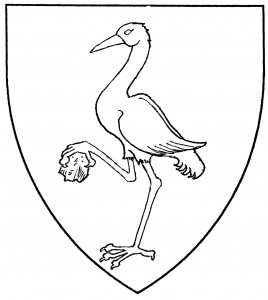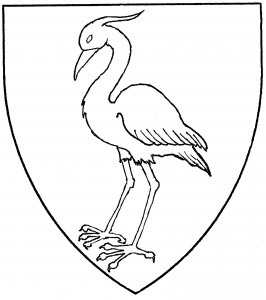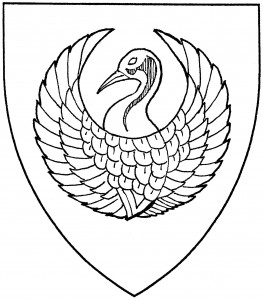The crane is a long-legged aquatic bird with a long neck and bill. It was often depicted “in its vigilance”, standing on one foot and grasping a stone in the other. The medieval bestiaries held that the crane would stand this way; should it fall asleep, it would drop the stone and awaken. As an heraldic charge, the crane dates from c.1270, in the canting arms (French grue) of the Counts de Gruyere [ANA2 191].
Similar to the crane are the “heron”, the “stork”, the “egret”, and the “ibis”. The heron is distinguished by the long tuft on its head; it’s found in the canting arms of Heron, c.1255 [ANA2 192]. The stork is often depicted with a serpent or eel in its bill, even when this is not specifically blazoned; it is found in the arms of Egglescliffe, Bishop of Llandaff, 1323 [DBA2 151]. The ibis and egret appear to be Society innovations, and are generally drawn as found in nature. All of these birds are close by default; though frequently drawn with one leg raised, this is considered an artistic detail, usually left unblazoned.
A particular depiction of the crane is the “Japanese crane” (tsuru): legless, with its wings displayed in annulo, the whole forming almost a crescent. It was used in the Mon of Mori Nagayoshi, d.1585 [Hawley 48]. The Japanese crane is permitted in Society armory, but as a non-European charge, it carries a step from period practice.
Grimbold of Settmour bears: Ermine, a crane in its vigilance azure.
Brennan O Loughran bears: Azure, two herons addorsed argent.
Karl von Süssen bears: Vert, a stork passant, wings elevated and addorsed argent, grasping in its beak a fish Or, all within a bordure argent.
Sybilla Keisalovitch bears: Argent, an ibis close to sinister reguardant, dexter leg upraised gules, within a bordure compony gules and argent.
Kamiizumi Hirotarō bears: Argent, a Japanese crane displayed purpure.


